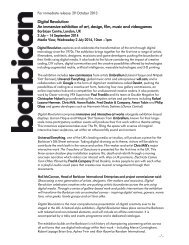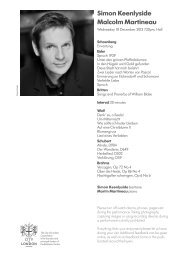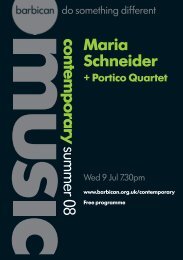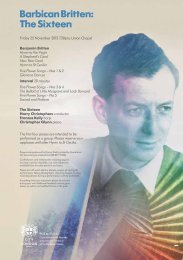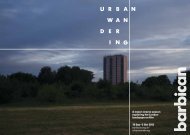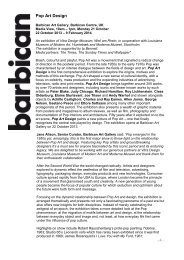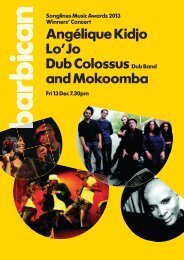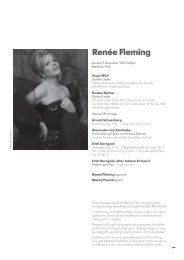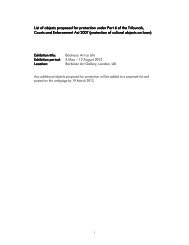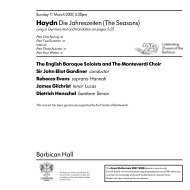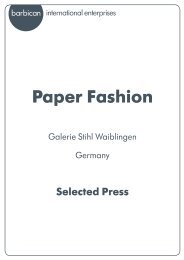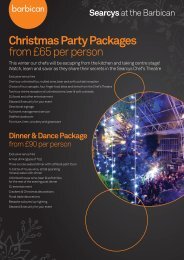Download your concert programme here - Barbican
Download your concert programme here - Barbican
Download your concert programme here - Barbican
Create successful ePaper yourself
Turn your PDF publications into a flip-book with our unique Google optimized e-Paper software.
Wednesday 3 February<br />
soundscapes that, in many cases, seem more relaxed and<br />
less insistently close to overload; some might even be<br />
described as smooth or spacious. That said, many of<br />
Lindberg’s scores, even those in the modern ‘classicist’<br />
mode, remain generally vigorous, colourful, dense and<br />
kinetic and, despite the extreme refinement of his<br />
compositional method, his scores manage to sound very<br />
spontaneous.<br />
Although he has worked in a variety of genres, Lindberg has<br />
carved out a particular reputation as a composer of<br />
orchestral music. ‘The orchestra’, he has declared, ‘is my<br />
favourite instrument.’ Symphonic works of the past decade<br />
or so include Feria (whose American premiere was given by<br />
the New York Philharmonic in 1997, conducted by Jukka-<br />
Pekka Saraste), a Concerto for Orchestra (2002) and<br />
<strong>concert</strong>os for cello (1999), clarinet (2002) and violin (2006).<br />
Among his most recent works is Seht die Sonne (‘Behold the<br />
Sun’), jointly commissioned by the Berlin Philharmonic and<br />
the San Francisco Symphony, and described in the Financial<br />
Times as ‘an extravagant and glittering piece on a grand<br />
scale’. These scores reveal Lindberg’s increasing interest in<br />
presenting clear-cut melody, sometimes even of a folkish tint,<br />
underscoring that even after composing some 80 works he<br />
continues to develop an idiosyncratic path of personal<br />
creative discovery.<br />
About EXPO – Magnus Lindberg’s first work written for the<br />
New York Philharmonic and also the first piece that Alan<br />
Gilbert conducted as the Orchestra’s Music Director, on<br />
16 September 2009 – the composer has offered the<br />
following thoughts:<br />
‘The title is self-explanatory; it’s the exposition of Alan’s<br />
season. I work with extremely strong contrasts, setting up<br />
some contrasts between super-fast and super-slow music<br />
and then a strange amalgam between these poles. It’s a<br />
piece built on qualities I find so gorgeous in Alan’s way of<br />
making music – absolute technical and physical straightness,<br />
no mystery around the rational part of it, and then on top of<br />
that the highly irrational and mysterious part of how you<br />
actually put music together.<br />
Given the brevity of the piece – 9 or 10 minutes – I thought a<br />
pithy word such as “EXPO” would make a fitting title;<br />
besides, I like the sound of the word. A work of any length<br />
must have a trajectory, a sense of direction and logic about<br />
the way it evolves. I have tried to establish a musical<br />
language to communicate this drama. As short as EXPO is,<br />
t<strong>here</strong> are more than 10 tempo markings, resulting in a<br />
feeling of great tension and energy in the orchestra.’<br />
Programme note © James M. Keller, New York Philharmonic<br />
Program Annotator<br />
3




